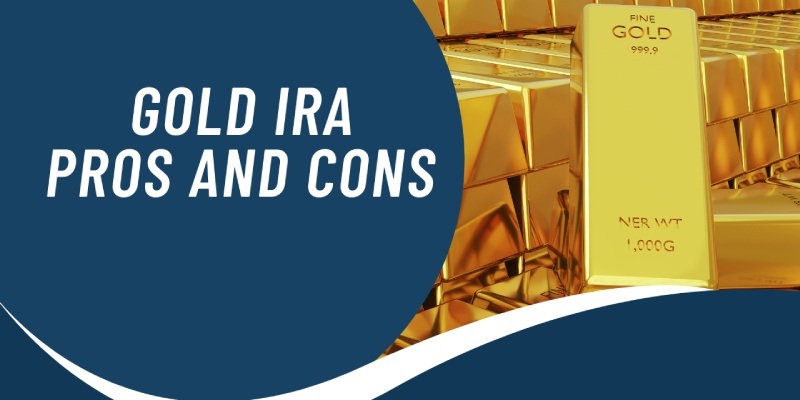

Investing in a Gold IRA presents both opportunities and considerations for retirement planning. A Gold IRA, or individual retirement account, allows investors to diversify their portfolios by including physical gold and other precious metals.
In this article, we’ll find the various gold IRA pros and cons, shedding light on their potential benefits and drawbacks in today’s financial landscape. From tax advantages to market volatility, understanding the intricacies of gold IRAs is essential for making informed investment decisions.
Top Rated Gold IRA Companies of 2024
This section aims to simplify the process by highlighting the top-rated Gold IRA companies of 2024. By examining factors such as reputation, customer service, fees, and reliability, investors can make informed decisions about entrusting their retirement savings to reputable and highly-rated custodians.
Here are some of the top Gold IRA companies to consider this year:
- Augusta Precious Metals: Editor’s Choice — Best Overall Choice for Gold IRAs (4.9/5)
- American Hartford Gold: Runner Up – High Quality Gold Assets (4.8/5)
- Goldco: Remarkable Customer Service for Gold IRAs (4.6/5)
- Birch Gold Group: 24/7 Customer Support (4.2/5)
- Lear Capital: Straightforward Gold IRA Processing (4/5)
#1. Augusta Precious Metals: Editor’s Choice — Top Gold IRA Company of 2024 (4.9/5)
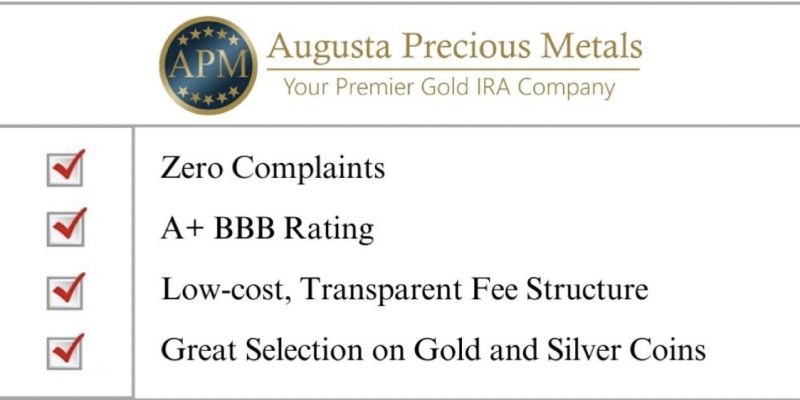
>>> Click here for FREE Gold IRA Kit From Augusta Precious Metals <<<
Pros:
- Excellent reputation and customer reviews.
- Competitive fees and transparent pricing.
- Superior customer service and personalized guidance.
- Wide range of precious metals available.
Cons:
- Minimum investment requirement of $50,000 may be prohibitive for some investors.
- Limited educational resources compared to some competitors.
Precious Metals Available:
- Gold
- Silver
- Platinum
- Palladium
Minimum Investment:
$50,000
Company Background
Augusta Precious Metals, founded in 2012, has established itself as a leader in the precious metals industry, specializing in Gold IRAs and other retirement accounts. With a commitment to integrity, transparency, and customer satisfaction, Augusta Precious Metals has earned a stellar reputation among investors and industry experts alike.
The company’s team of seasoned professionals provides personalized guidance and support to clients, helping them navigate the complexities of precious metal investing and achieve their financial goals.
Why Augusta Precious Metals?
- Excellent reputation and customer reviews.
- Competitive fees and transparent pricing.
- Superior customer service and personalized guidance.
- Wide range of precious metals available.
>>> Click here for FREE Gold IRA Kit From Augusta Precious Metals <<<
#2. American Hartford Gold: Runner Up – Premium Gold Selections (4.8/5)
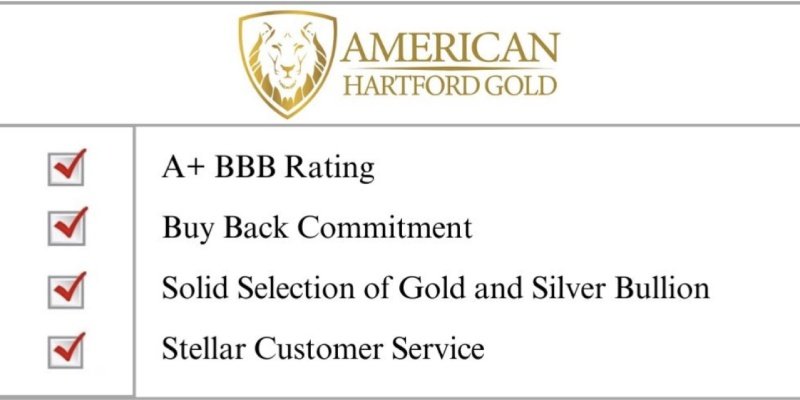
>>>Click Here for Free Gold IRA Kit American Hartford Gold<<<
Pros:
- Highly rated customer service.
- Competitive pricing and transparent fee structure.
- Diverse selection of precious metals available.
- Flexible minimum investment requirement.
Cons:
- Limited selection of educational resources.
- Some clients report delays in account setup.
Precious Metals Available:
- Gold
- Silver
- Platinum
- Palladium
Minimum Investment:
$10,000
Company Background
American Hartford Gold, established in 2009, is recognized as a leading provider of precious metals IRA services, offering a wide range of gold and other precious metal products to investors seeking to diversify their retirement portfolios.
With a focus on customer satisfaction and financial security, American Hartford Gold has built a solid reputation for reliability, transparency, and integrity in the industry. The company’s experienced team of professionals is dedicated to providing personalized assistance and expert guidance to clients, helping them navigate the complexities of precious metal investing and achieve their long-term financial goals.
Why American Hartford Gold?
- Highly rated customer service.
- Competitive pricing and transparent fee structure.
- Diverse selection of precious metals available.
- Flexible minimum investment requirement.
>>>Click Here for Free Gold IRA Kit American Hartford Gold<<<
#3. Goldco: Responsible Customer Service (4.6/5)
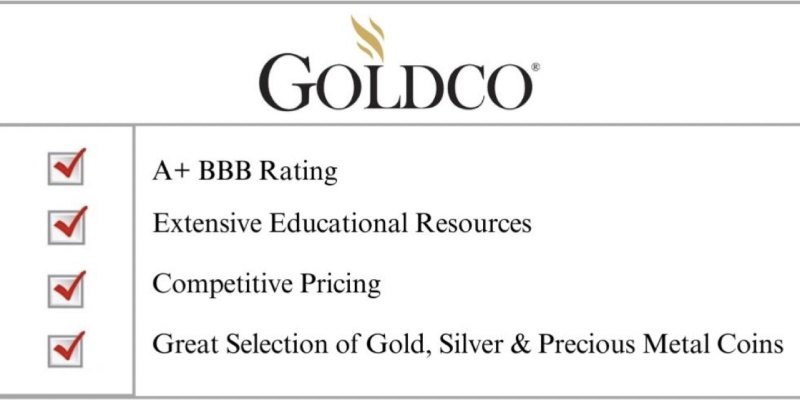
>>> Click here to learn more about Goldco <<<
What We Liked About Goldco:
- Commitment to responsible customer service.
- Knowledgeable and responsive customer support team.
- Transparent fee structure and competitive pricing.
- Variety of educational resources available to investors.
Precious Metals Available:
- Gold
- Silver
- Platinum
- Palladium
Minimum Investment:
$25,000
Company Background
Goldco, founded in 2006, has established itself as a trusted name in the precious metals IRA industry, renowned for its commitment to responsible customer service and investor satisfaction.
With over a decade of experience, Goldco offers a comprehensive range of gold and other precious metal products, catering to the diverse needs and preferences of investors seeking to safeguard their retirement savings.
The company’s dedicated team of professionals strives to provide personalized assistance and expert guidance to clients, empowering them to make informed decisions and achieve their long-term financial objectives.
Why Goldco?
- Commitment to responsible customer service.
- Knowledgeable and responsive customer support team.
- Transparent fee structure and competitive pricing.
- Variety of educational resources available to investors.
>>> Click here to learn more about Goldco <<<
#4. Birch Gold Group: Awesome Staff (4.2/5)
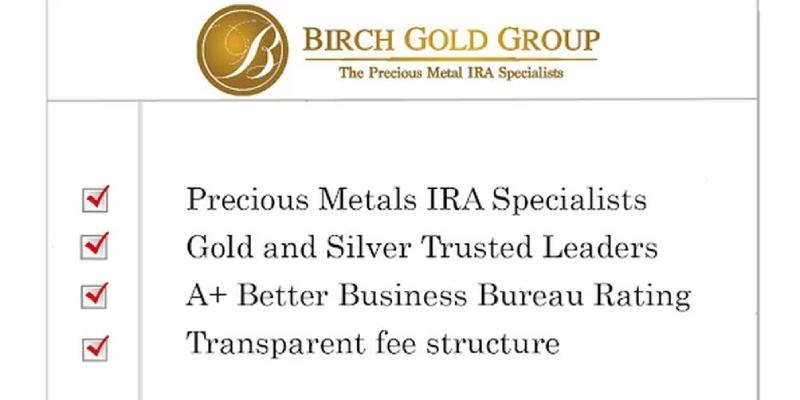
>>>Click Here for Free Gold IRA Kit Birch Gold<<<
Pros:
- Highly knowledgeable and friendly staff.
- Wide range of precious metals available.
- Transparent fee structure.
- Excellent customer service and support.
Cons:
- Minimum investment requirement of $10,000 may be prohibitive for some investors.
- Limited educational resources compared to some competitors.
Precious Metals Available:
- Gold
- Silver
- Platinum
- Palladium
Minimum Investment:
$10,000
Company Background
Birch Gold Group, founded in 2003, has established itself as a reputable and customer-focused precious metals company, dedicated to providing investors with comprehensive solutions for diversifying their portfolios with gold, silver, platinum, and palladium.
With a team of highly knowledgeable and friendly staff, Birch Gold Group offers personalized guidance and support to clients, ensuring that their investment needs and goals are met with integrity and professionalism.
Why Birch Gold Group?
- Highly knowledgeable and friendly staff.
- Wide range of precious metals available.
- Transparent fee structure.
- Excellent customer service and support.
>>>Click Here for Free Gold IRA Kit Birch Gold<<<
#5. Lear Capital: Best Account Opening Support (4/5)
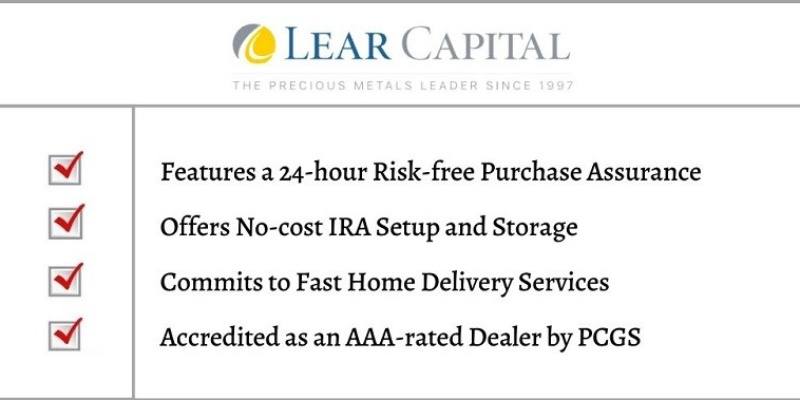
>>>Click Here for Free Gold IRA Kit Lear Capital<<<
Pros:
- Exceptional account opening support.
- Wide selection of precious metals available.
- Transparent fee structure.
- Dedicated customer service team.
Cons:
- Minimum investment requirement of $15,000 may be prohibitive for some investors.
- Limited educational resources compared to some competitors.
Precious Metals Available:
- Gold
- Silver
- Platinum
- Palladium
Minimum Investment:
$15,000
Company Background
Lear Capital has positioned itself as a reputable and customer-centric precious metals company. Specializing in providing investors with access to a wide variety of gold, silver, platinum, and palladium products, Lear Capital prides itself on offering exceptional account opening support.
Their transparent fee structure and dedicated customer service team further contribute to their reputation as a reliable partner for precious metal investments.
Why Lear Capital?
- Exceptional account opening support.
- Wide selection of precious metals available.
- Transparent fee structure.
- Dedicated customer service team.
>>>Click Here for Free Gold IRA Kit Lear Capital<<<
Gold IRA Pros and Cons
With the potential to hedge against inflation and economic uncertainty, Gold IRAs provide investors with a tangible asset that has historically preserved wealth. However, there are also considerations such as storage fees and liquidity concerns that warrant careful evaluation.
Here are the pros and cons of Gold IRAs, providing insight into their benefits and drawbacks for savvy investors:
Pros of a Gold IRA
- Diversification: Gold IRAs offer diversification beyond traditional assets like stocks and bonds, reducing overall portfolio risk.
- Inflation Hedge: Gold has historically served as a hedge against inflation, preserving purchasing power over time.
- Tangible Asset: Unlike paper investments, gold is a physical asset that holds intrinsic value, providing a sense of security during economic downturns.
- Tax Advantages: Gold IRAs enjoy similar tax benefits as traditional IRAs, such as tax-deferred growth and potential tax deductions for contributions.
- Portfolio Protection: During periods of market volatility or currency devaluation, gold tends to maintain its value, acting as a buffer against losses.
- Global Demand: Gold’s universal appeal ensures liquidity and demand worldwide, making it a reliable store of value.
Cons of a Gold IRA
- Storage Costs: Storing physical gold can incur additional expenses, including insurance and secure storage fees.
- Illiquid Asset: Selling physical gold may take longer and involve higher transaction costs compared to selling stocks or bonds.
- Volatility: While gold can provide stability, its price can also be subject to significant fluctuations, affecting short-term investment returns.
- Limited Returns: Unlike dividend-paying stocks or interest-bearing bonds, gold does not generate income, potentially limiting long-term returns.
- Regulatory Risks: The IRS imposes strict regulations on Gold IRAs, requiring compliance with purity standards and custodian requirements.
- Counterparty Risk: Depending on the custodian, there may be risks associated with the financial stability or reputation of the institution.
History of Gold Prices
The history of gold prices reflects its enduring allure as a timeless asset and its resilience in times of economic and geopolitical instability. As global dynamics continue to evolve, gold remains a cornerstone of wealth preservation and a barometer of market sentiment.
Pre-20th Century
Gold has been valued for its rarity and beauty for millennia, serving as a medium of exchange and a store of value across ancient civilizations.
From the reign of King Croesus of Lydia in the 6th century BCE to the Roman Empire, gold coins became synonymous with wealth and power. During the Middle Ages, the Byzantine Empire’s solidus and the Islamic dinar maintained gold’s prominence in trade and commerce.
The discovery of the New World in the 15th century led to a significant influx of gold from the Americas, influencing global economies and contributing to the rise of mercantilism.
Gold Standard Era (19th – Early 20th Century)
The 19th century saw the widespread adoption of the gold standard, where currencies were pegged to a fixed amount of gold. The stability of the gold standard fostered economic growth and facilitated international trade.
However, the rigidity of the system became evident during economic downturns, leading to periodic financial crises. The Gold Rushes of the 19th century, particularly in California and Australia, further fueled the supply of gold, influencing global prices.
20th Century and Beyond
The 20th century witnessed significant fluctuations in gold prices amid geopolitical tensions, economic upheavals, and shifts in monetary policy. The aftermath of World War I saw countries abandoning the gold standard to finance war debts, leading to currency devaluations and hyperinflation in some cases.
The Great Depression prompted governments to reevaluate their monetary policies, with the Bretton Woods Agreement in 1944 establishing a fixed exchange rate system anchored to gold. However, the system collapsed in 1971 when President Nixon ended the convertibility of the US dollar into gold, ushering in an era of floating exchange rates.
Recent Trends
In the late 20th and early 21st centuries, gold prices experienced unprecedented volatility driven by factors such as geopolitical uncertainty, central bank policies, and fluctuations in global demand.
The 2008 financial crisis spurred a surge in gold prices as investors sought safe-haven assets amid market turmoil. Subsequent economic stimulus measures, along with low interest rates, fueled demand for gold as an inflation hedge and portfolio diversifier.
The COVID-19 pandemic further intensified gold’s appeal, pushing prices to record highs in 2020 as investors sought refuge from economic uncertainty and currency debasement.
Why Are Gold IRAs Popular Today?
Gold IRAs have surged in popularity in recent years as investors seek to safeguard their retirement savings against economic volatility and inflationary pressures.
This section finds the key reasons behind the growing popularity of Gold IRAs in today’s financial landscape:
Hedging Against Economic Uncertainty
In an era marked by geopolitical tensions, trade disputes, and market volatility, Gold IRAs offer investors a reliable hedge against economic uncertainty. Gold has historically maintained its value during times of crisis, making it an attractive asset for protecting wealth. With concerns about inflation and currency devaluation, investors view gold as a safe haven that can preserve purchasing power over the long term.
Portfolio Diversification
Diversification is a fundamental principle of sound investing, and Gold IRAs provide an effective means of diversifying retirement portfolios. By adding physical gold to their investment mix, investors can reduce overall portfolio risk and mitigate the impact of market downturns. Gold’s low correlation with traditional assets like stocks and bonds makes it an ideal diversifier, enhancing portfolio resilience and stability.
Preservation of Purchasing Power
Gold IRAs enable investors to preserve the purchasing power of their retirement savings in the face of rising inflation. Unlike paper currencies that can lose value over time due to inflationary pressures, gold has maintained its purchasing power for centuries. By allocating a portion of their retirement funds to gold, investors can protect against the erosive effects of inflation and ensure their financial security in retirement.
Tax Advantages
Gold IRAs offer similar tax benefits to traditional IRAs, making them an attractive option for retirement savings. Contributions to Gold IRAs may be tax-deductible, reducing current tax liabilities for investors. In addition, gold held within an IRA enjoys tax-deferred growth, allowing investors to compound their returns over time without immediate tax consequences. When distributions are taken in retirement, they may be subject to ordinary income tax rates, but investors can potentially benefit from lower tax brackets during retirement.
Global Demand and Liquidity
Gold is a universally recognized asset with a deep and liquid market, making it easy for investors to buy, sell, and trade their holdings. Unlike other alternative investments that may lack liquidity, gold can be easily converted into cash or other assets, providing investors with flexibility and accessibility. With growing demand for gold from emerging markets and central banks, investors can have confidence in the long-term liquidity and value of their Gold IRA holdings.
Traditional IRA Vs Roth IRA
Choosing between a Traditional IRA and a Roth IRA is a pivotal decision for retirement planning, as each option offers distinct tax advantages and considerations.
This section outlines the key differences between Traditional and Roth IRAs, helping investors make informed decisions based on their financial goals and circumstances.
Traditional IRA
- Tax Treatment: Contributions to a Traditional IRA are typically tax-deductible, allowing investors to deduct their contributions from their taxable income for the year, providing an immediate tax benefit. This deduction can reduce current tax liabilities, potentially lowering the investor’s overall tax bill.
- Tax Deferral: Investments held within a Traditional IRA grow tax-deferred until withdrawals are made in retirement. This means that investment earnings can compound over time without being subject to annual taxes on gains, maximizing growth potential and allowing for greater accumulation of retirement savings.
- Required Minimum Distributions (RMDs): Traditional IRA holders are required to start taking minimum distributions from their accounts each year starting at age 72 (as of 2022). These RMDs are calculated based on the account balance and the investor’s life expectancy and are subject to ordinary income tax. RMDs are intended to ensure that investors gradually withdraw their retirement savings during their golden years.
Roth IRA
- Tax Treatment: Contributions to a Roth IRA are made with after-tax dollars, meaning investors cannot deduct their contributions from their taxable income. While this means no immediate tax benefit, qualified withdrawals from a Roth IRA, including earnings, are tax-free in retirement, providing tax-free income during retirement.
- Tax-Free Growth: Investments held within a Roth IRA grow tax-free, provided certain conditions are met. This means that investment earnings can compound over time without being subject to taxes, allowing for potentially greater accumulation of retirement savings and tax-free income in retirement.
- No Required Minimum Distributions (RMDs): Unlike Traditional IRAs, Roth IRAs do not have required minimum distributions during the account holder’s lifetime. This gives investors greater flexibility in managing their retirement savings, allowing them to leave their assets untouched for as long as they wish. This flexibility can be particularly advantageous for estate planning purposes, as Roth IRA assets can potentially be passed on to heirs tax-free.
Choosing Between Traditional and Roth IRAs
The decision between a Traditional and Roth IRA ultimately depends on factors such as current tax situation, future tax expectations, investment timeline, and retirement goals.
While Traditional IRAs offer immediate tax benefits and tax-deferred growth, Roth IRAs provide tax-free withdrawals in retirement and greater flexibility with RMDs.
By evaluating these factors and consulting with a financial advisor, investors can determine the IRA option that best aligns with their individual circumstances and long-term objectives.
Do I Need a Custodian for My Gold IRA?
Yes, you do need a custodian for your Gold IRA. The Internal Revenue Service (IRS) requires that all Gold IRAs be held by a qualified trustee or custodian.
These custodians are responsible for overseeing the administration of the IRA, including the purchase, storage, and reporting of precious metals held within the account. In addition, custodians ensure compliance with IRS regulations regarding the purity and storage of gold assets.
Benefits of Hiring a Custodian for Your Gold IRA
Hiring a custodian for your Gold IRA offers several advantages, providing peace of mind and ensuring compliance with IRS regulations. Here are the benefits of entrusting your Gold IRA to a qualified custodian:
- Expertise and Experience: Custodians specialize in managing retirement accounts and have extensive experience handling precious metal investments. Their expertise ensures proper administration and compliance with IRS rules and regulations, minimizing the risk of costly mistakes or penalties.
- Secure Storage: Custodians provide secure storage solutions for your gold assets, protecting them from theft, loss, or damage. Professional storage facilities offer advanced security measures, including surveillance, insurance, and physical safeguards, ensuring the safety of your investments.
- Compliance Assurance: Custodians ensure compliance with IRS regulations regarding the purity, quality, and storage of gold assets held within your IRA. By adhering to regulatory requirements, custodians help safeguard the tax-advantaged status of your retirement account and mitigate the risk of IRS audits or penalties.
- Administrative Support: Custodians handle all administrative tasks related to your Gold IRA, including account setup, asset purchases, record-keeping, and reporting. Their efficient and reliable services streamline the management of your retirement savings, allowing you to focus on your investment strategy and financial goals.
- Professional Guidance: Custodians offer personalized guidance and support to help you make informed decisions about your Gold IRA investment. Whether you’re considering asset allocation, diversification strategies, or distribution options, custodial advisors provide valuable insights and recommendations tailored to your individual needs and objectives.
- Peace of Mind: By entrusting your Gold IRA to a reputable custodian, you gain peace of mind knowing that your retirement savings are in capable hands. Custodians prioritize the security, compliance, and performance of your investment, allowing you to enjoy greater confidence and security in your financial future.
Gold IRA Costs and Expenses
Understanding the costs and expenses associated with a Gold IRA is essential for making informed investment decisions and maximizing returns.
This section examines the various costs involved in establishing and maintaining a Gold IRA, helping investors assess the overall affordability and value of this retirement investment option.
- Setup Fees: Many Gold IRA custodians charge setup fees to establish your account, covering administrative expenses such as account creation and paperwork processing. These fees vary among custodians and may range from a flat rate to a percentage of the total investment.
- Annual Maintenance Fees: Custodians typically levy annual maintenance fees to cover ongoing administrative and storage costs associated with managing your Gold IRA. These fees may be fixed or based on a percentage of your account balance, and they vary depending on the custodian and the services provided.
- Storage Fees: Storing physical gold requires secure facilities equipped with advanced security measures, which often incur storage fees. Custodians pass these costs on to investors to cover the expenses of storing and safeguarding their gold assets. Storage fees may be charged annually or monthly and can vary based on factors such as the quantity and type of gold held.
- Transaction Fees: Buying and selling gold within your IRA may incur transaction fees, including brokerage commissions or dealer markups. These fees can impact the overall cost-effectiveness of your investment strategy and should be considered when evaluating the potential returns of your Gold IRA.
- Insurance Costs: Custodians typically insure the gold held within your IRA to protect against theft, loss, or damage. Insurance costs are factored into the overall expenses of managing your Gold IRA and may be included in storage fees or billed separately.
- Miscellaneous Expenses: Additional expenses such as account closure fees, transfer fees, or expedited processing fees may apply in certain situations. It’s important to review the fee schedule provided by your custodian and inquire about any potential miscellaneous expenses that could affect your Gold IRA investment.
What is a Gold IRA Rollover?
A Gold IRA rollover refers to the process of transferring funds from an existing retirement account, such as a Traditional IRA, 401(k), or another eligible retirement plan, into a Gold IRA. This maneuver allows investors to convert their retirement savings from traditional assets, such as stocks and bonds, into physical gold or other approved precious metals.
The rollover process typically involves liquidating the assets in the original retirement account and reinvesting the proceeds into a Gold IRA. By executing a Gold IRA rollover, investors can diversify their retirement portfolios, hedge against inflation and economic uncertainty, and take advantage of the tax benefits associated with precious metal investments.
In addition, a Gold IRA rollover enables individuals to maintain the tax-deferred status of their retirement savings, preserving the potential for long-term growth and wealth accumulation.
Final Thoughts — Gold IRA Pros and Cons
Investing in a Gold IRA presents a unique opportunity for retirement planning, offering investors the potential to diversify their portfolios with physical gold and other precious metals. By understanding the pros and cons of Gold IRAs and conducting thorough research, investors can make informed decisions that align with their long-term financial goals.
Among the top-rated Gold IRA companies of 2024, Augusta Precious Metals stands out as the top Gold IRA company of the year. With an excellent reputation, competitive fees, superior customer service, and a wide range of precious metals available, Augusta Precious Metals offers investors a trusted and reliable partner for their precious metal investments.
While the minimum investment requirement of $50,000 may be prohibitive for some investors, those seeking a reputable and experienced custodian for their Gold IRA can benefit from Augusta Precious Metals’ commitment to integrity and customer satisfaction.
>>> Click here for FREE Gold IRA Kit From Augusta Precious Metals <<<
Frequently Asked Questions
1. How do I open a Gold IRA?
To open a Gold IRA, you’ll need to follow a few simple steps. First, choose a reputable custodian or trustee that offers Gold IRA services. Then, complete the necessary paperwork to establish your account. Next, fund your Gold IRA by transferring funds from an existing retirement account or making a contribution. Finally, work with your custodian to select the precious metals you wish to include in your IRA and ensure compliance with IRS regulations.
2. What are the storage requirements for a Gold IRA?
The Internal Revenue Service (IRS) requires that all precious metals held within a Gold IRA be stored in an approved depository or storage facility. These facilities must meet specific IRS guidelines for security, insurance, and segregation of assets. Most custodians partner with trusted storage providers to ensure that clients’ precious metal holdings are stored securely and compliantly.
3. Can I take physical possession of the gold in my Gold IRA?
While the IRS permits investors to take physical possession of the precious metals in their IRA under certain circumstances, doing so can have significant tax implications. Generally, distributions from a Gold IRA before reaching retirement age (59½) are subject to income tax and may incur early withdrawal penalties. Added to that, taking physical possession of IRA assets may disqualify the account as an IRA, resulting in adverse tax consequences.
4. What are the tax implications of a Gold IRA?
Gold IRAs enjoy similar tax benefits as traditional IRAs, such as tax-deferred growth and potential tax deductions for contributions. Contributions to a Gold IRA may be tax-deductible, reducing current tax liabilities for investors. Added to that, gold held within an IRA grows tax-deferred until distributions are taken in retirement, potentially allowing for greater accumulation of wealth. However, distributions from a Gold IRA are generally subject to ordinary income tax rates, and early withdrawals may incur additional penalties.
5. What happens to my Gold IRA when I reach retirement age?
When you reach retirement age (currently 72 years old as of 2022), you’ll be required to start taking minimum distributions from your Gold IRA, known as Required Minimum Distributions (RMDs). These distributions are calculated based on your account balance and life expectancy and are subject to ordinary income tax. It’s essential to plan for RMDs and consider their impact on your retirement income strategy and tax situation.
6. Can I rollover funds from my existing retirement account into a Gold IRA?
Yes, you can rollover funds from an existing retirement account, such as a Traditional IRA, 401(k), or another eligible retirement plan, into a Gold IRA. This process, known as a Gold IRA rollover, allows you to convert traditional assets like stocks and bonds into physical gold or other approved precious metals. By executing a Gold IRA rollover, you can diversify your retirement portfolio, hedge against inflation, and take advantage of the tax benefits associated with precious metal investments.
7. What are the advantages of investing in a Gold IRA?
Investing in a Gold IRA offers several potential advantages for retirement planning. Gold IRAs provide investors with a tangible asset that has historically preserved wealth and acted as a hedge against inflation and economic uncertainty. Also, gold’s low correlation with traditional assets like stocks and bonds makes it an effective diversifier, reducing overall portfolio risk. Gold IRAs also enjoy tax benefits similar to traditional IRAs, such as tax-deferred growth and potential tax deductions for contributions.
8. What are the risks associated with investing in a Gold IRA?
While Gold IRAs offer potential benefits, they also come with certain risks that investors should be aware of. These risks include market volatility, storage costs, liquidity concerns, regulatory compliance, and counterparty risk. Gold prices can be subject to significant fluctuations, affecting short-term investment returns. Added to that, storing physical gold can incur additional expenses, and selling gold may take longer and involve higher transaction costs compared to selling stocks or bonds. Regulatory compliance with IRS rules and regulations is also essential to maintain the tax-advantaged status of a Gold IRA. Finally, investors should consider the financial stability and reputation of their chosen custodian to mitigate counterparty risk.